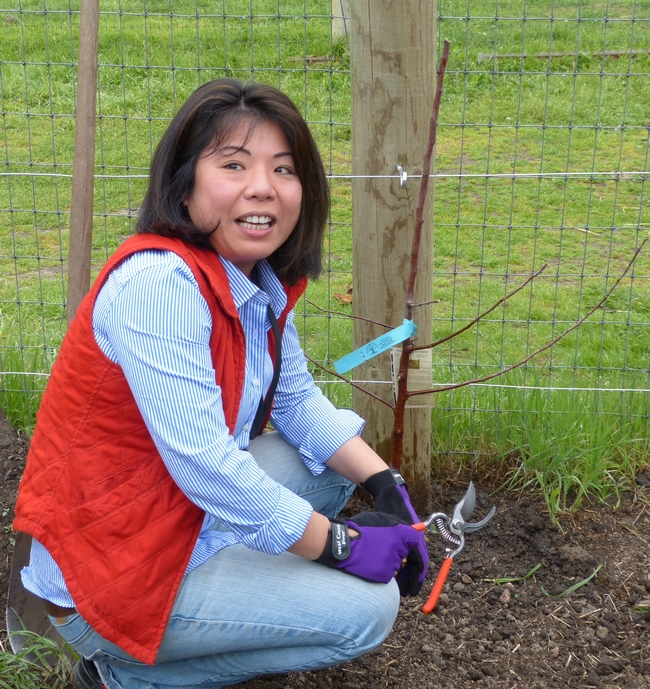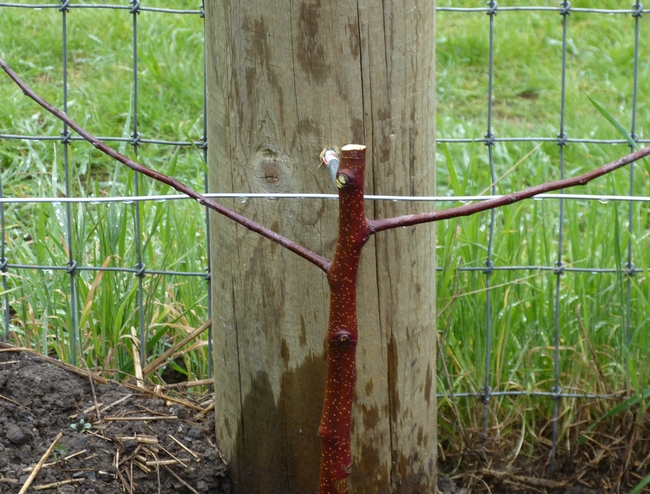
I've often felt overwhelmed by what seems like such a complicated task. But I've learned that pruning is really not difficult. My first tip is to be aware of how pruning affects your fruit trees.
Pruning strengthens branch structure, controls size for better fruit and easier harvesting and makes the tree more visually appealing.
If you wait until warmer weather to prune, the tree will no longer be dormant. You will waste a lot of the tree's energy if you cut off blossoms that it has already created. Pruning now increases fruit size and quality. But one of the big benefits of pruning in winter and early spring is that it's easy to see the branch structure without all those leaves.
A fruit tree's vertical branches tend to be vegetative, while horizontal branches tend to be fruiting. In other words, upright branches create the leaves that supply the energy the tree needs to grow fruit. It takes both types of branches to create good fruit.
Shade inhibits flower production on fruiting branches. If overly shaded, the tree will only set fruit on the outside edges of the branches. Good pruning produces a canopy that allows for air and light flow and makes it easier to thin and harvest fruit.
You will need clean pruning shears, loppers with a 24- to 30-inch handle, and an 8- to 15-inch curved-blade pruning saw. Do not use any kind of sealer when cutting branches. Let the tree use its own natural defenses to heal the cut.
Step 1: Clean up the tree. Remove any suckers growing straight up from the roots and rootstock. Remove any dead or diseased branches and any crossing branches that are rubbing each other. If you remove diseased branches, disinfect your shears between cuts with a 10 percent bleach solution to keep from spreading the disease to other branches. Don't leave stubs. Make cuts close to the branch or trunk.
Step 2: Thin branches to allow light and air into the canopy. A good rule of thumb is to leavesix to twelve inches of air space around branches. Smaller branches need less air space than larger ones. Branches that bend downward eventually lose vigor and produce fewer and smaller fruit. Cut off the part that is hanging down. Now look for any straight, thin, vigorous branches growing straight up from the trunk or other branches. These water sprouts mainly produce leaves. They block light and air so remove them.
Strong branches that can bear the weight of fruit grow at angles of 45 to 60 degrees. If necessary, you can often bend younger, flexible branchesto force a proper angle using sticks, clothespins or ties. If a branch has hardened into a bad position, it's probably best to remove it.
Step 3: Head back and shape.This last step is easy because you're just giving the tree a haircut. Removingsome of last year's branch growth makes a stronger support for fruit. Sun-exposed wood produces the most and the largest fruit. Do most of your heading at the top of the tree to allow light to reach lower branches. Most people prefer keeping a fruit tree under eight feed to make it possible to harvest without a ladder.
Annual branch growth can be anywhere from two inches to four feet depending upon the tree's vigor, but you should be able to identify new growth by the wrinkly ring of bark encircling each stem.
Make heading cuts within ¼-inch of a bud. New growth occurs where you make the cut, so cut just above buds that face in the direction you want the branch to grow. That bud is in charge and says, “We're going this way” to the branch.
On peach and nectarine trees, remove half of last year's growth. On fig, apple, pear, plum and apricots, remove about 20 percent of last year's growth. Cherry trees are an exception; they are only pruned in summer.
Now sit back and prepare to enjoy the fruits of your labor. If you have questions about pruning or gardening, don't hesitate to call or visit the UC Master Gardeners of Napa County. See office hours and phone numbers below.
Workshop: UC Master Gardeners of Napa County will host a workshop on “Garden Planning” on Sunday, January 24, from 1 p.m. to 3 p.m. at the Yountville Community Center, 6516 Washington Street, Yountville. At a loss about what and where to plant in your own garden? Aren't sure of the factors that lead to a thriving yard? Home gardeners will examine their own garden's microclimates and receive tips and direction for choosing sites and plants suited to their particular locations and microclimates. To register, call the Parks and Recreation Department at 707-944-8712 or visit its website.
Master Gardeners are volunteers who help the University of California reach the gardening public with home gardening information. U. C. Master Gardeners of Napa County ( http://ucanr.org/ucmgnapa/) are available to answer gardening questions in person or by phone, Monday, Wednesday and Friday, 9 a.m. to Noon, at the U. C. Cooperative Extension office, 1710 Soscol Avenue, Suite 4, Napa, 707-253-4143, or from outside City of Napa toll-free at 877-279-3065. Or e-mail your garden questions by following the guidelines on our web site. Click on Napa, then on Have Garden Questions? Find us on Facebook under UC Master Gardeners of Napa County.
Attached Images:
